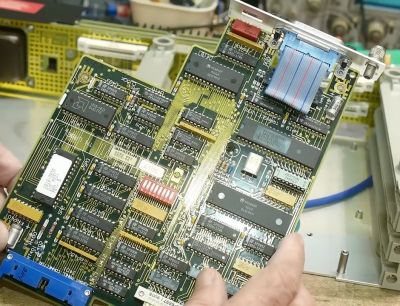[IMSAI Guy] has an old HP 3488A Switch Control Unit that he wants to dismantle for parts ( see video below the break ). The 3488A is pretty simple as far as HP test equipment goes — a chassis that can hold various types of relay cards and is programmable over GPIB. He notes up front that these are plentiful and inexpensive in the used test equipment market.
Around the back of the unit is a card cage that accepts up to five option cards providing
- 4×4 matrix switching
- on/off SPST switching
- switching signals to a common bus
- VHF switching
- Digital I/O signalling
The teardown is an interesting glimpse into the solid engineering design of 1980s HP test equipment. The option cards are well shielded, and have an interesting back panel connector that breaks out the signals to screw terminals and provides strain relief. The brains of switcher was a Motorola 6809 and connectivity was provided by an Intel 8291A GPIB interface chip. The power supply is solid, and many of its parts can be reused on other projects, such as the transformer and a beefy 20W DC-DC converter by ST. [IMSAI Guy] also scores a bunch of latching relays from the option cards which will no doubt come in handy on future projects.
These kinds of programmable relays can be very useful when building automated test fixtures. There were other solutions for this as well, back in the day. Metrabyte ( bought by Keithley, bought by Tektronix ) was one company that made a whole line of switching interface modules that hooked up to your PC’s ISA bus. Omron also offered similar products. Have you ever needed banks of programmable relays for your projects? If so, let us know your solution in the comments below.
















What’s the point to dismantle it for pieces if he cannot determine what the parts are, since they are labelled with HP codes….. ???
There are cross-references online which, in many cases, can help you identify HP parts. Manuals from BAMA and elsewhere can help you figure out the characteristics of other parts, like power transformers, for example.
For a really interesting version, look up the HP59306A Relay Actuator. HPIB but without even a microprocessor, all done in 74 series logic.
I’ve built several custom RF switch test rigs with lots of switching channels, but I dispensed with HPIB and went straight to ethernet from SBC running simple python code. (Beage/RPi/whatever is in the drawer).
Add on an ethernet GPIB adapter for the rest of the test equipment, and one of my products tests and calibrates itself from the onboard CM4, using cal data downloaded from the web server on the RF switch.
No need for a PC in the test rig, and the correct version of test code is bundled with the main equipment code image.
It got torn apart? With a USB to IEE488 adapter (~$10) and the correct HP 3488A cards you could automate your home with likely the best built IOT interface to be had. Now or back in the 80’s when this was new.
USB to IEEE488 for $10? Used one on eBay are more in the $100 ballpark.
Ah! You are correct. I checked on my search (“usb to iee488”) and the 1st (advertised) link was actually a $10 parallel printer adapter. Bummer.
Try the AR488 on eevblog. The most expensive part is the 24-pin connector (and you could always hardwire it into the interface box)
I’ve been thinking about picking one of these up and using it completely unaltered. To connect a bunch of small batteries, one at a time, to a tester, to monitor their self-discharge over time. And possibly move low currents in and out of them; I have months so I don’t care if the relays can’t handle massive current.
I use the direct descendant of this in my day job, to do stuff very like what you’re talking about. The 3488 had a digital I/O card for it that would be capable of driving higher current (or preferably solid state) relays. They’re fast and reliable. On the one I use, the firmware even keeps track of how many times individual mechanical relays have cycled so you can replace them if they’re getting up near the MTBF numbers. It’s a little like having a cheap PXI system, and it’s sure nice to have it programmable. I sometimes have to test what happens if a chip output is shorted to VCC or ground a million times in a row and whether it survives or not, and an automated test system like this is the only reasonable way to do work like that.
I wrote the code on that 6809! And the display used the same chipset as the HP41 calculator.